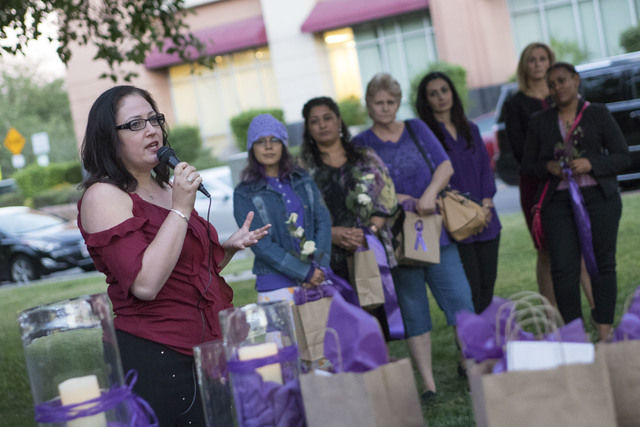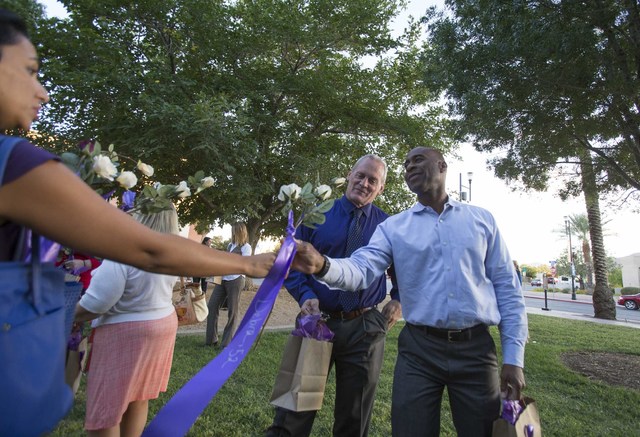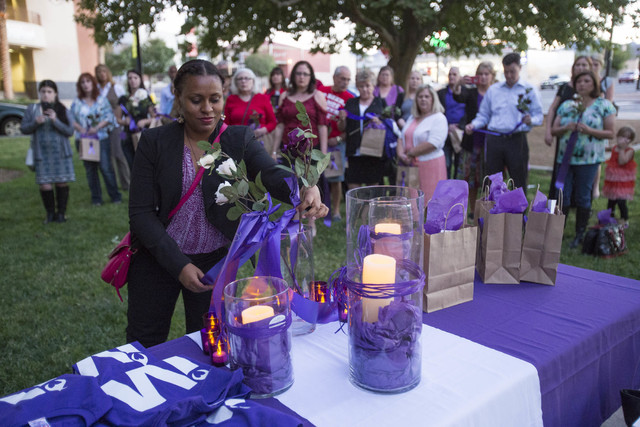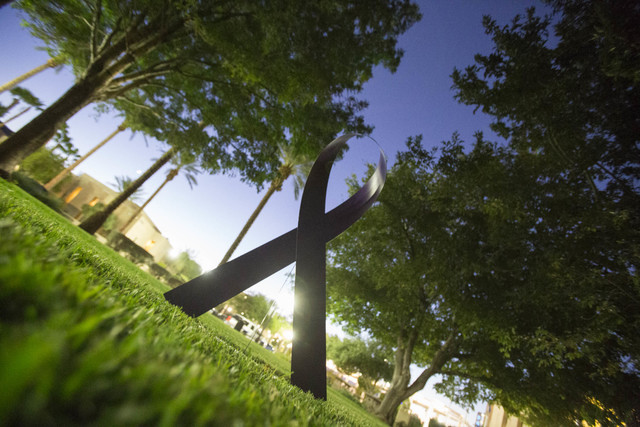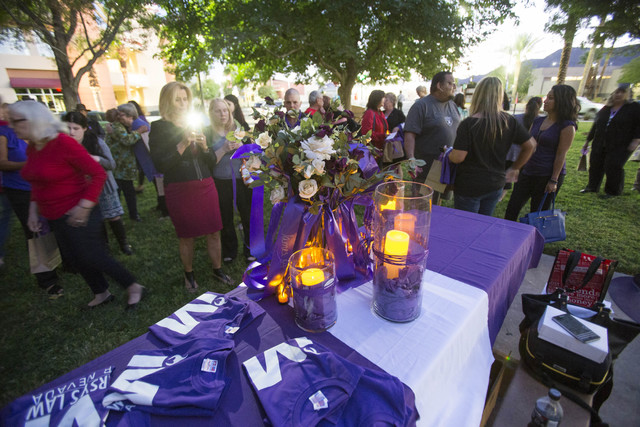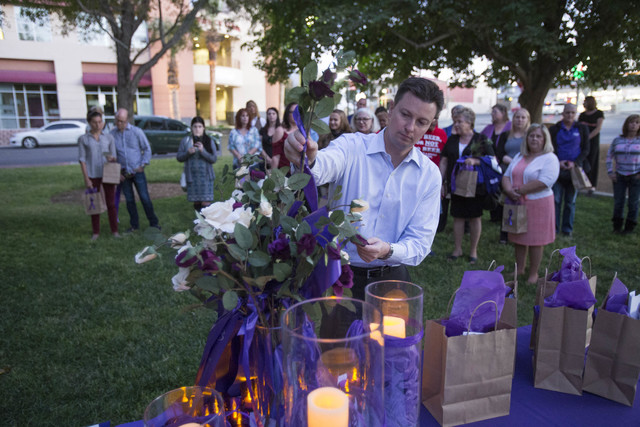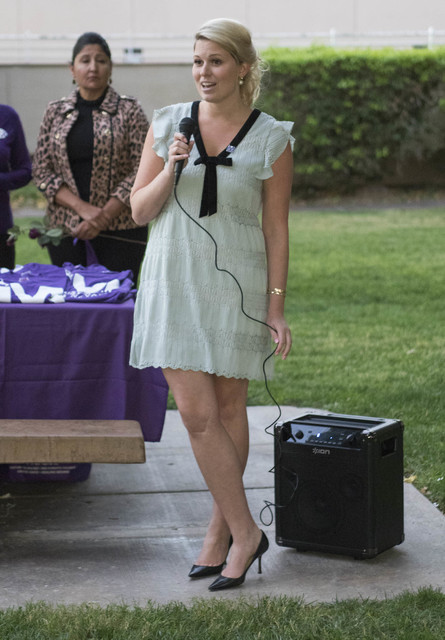Those battling domestic violence in Las Vegas find more to teach about signs of abuse
Gina knew her neighbors could hear the abuse from their homes. Yet they did nothing.
For many years, Gina, whose last name is being withheld to protect her identity, suffered somewhat in silence while friends, fellow church members and people in her community didn’t know how to respond to the domestic violence she was facing.
“I don’t fault my church,” she said. “They aren’t trained to handle this.”
According to the National Coalition Against Domestic Violence (NCADV), one in three women and one in four men have been victims of physical violence by an intimate partner in their lifetime. Though it happens so frequently, not everyone is equipped to recognize it and see the warning signs of physical and emotional abuse.
“People minimize what is happening,” said Annette Scott, community development and education coordinator for the Henderson-based domestic violence shelter SAFE House. “If they don’t see broken arms, black eyes or what they are used to seeing in the movies, they don’t recognize what’s happening.”
With advocates and decades-long campaigns, the concept of domestic abuse and intimate partner violence has been made more public in recent years. However, there is still more to teach when it comes to recognizing the signs of abuse.
WATCHING FOR WARNING SIGNS
Nancy Slater, who wears a purple streak in her hair in honor of Domestic Violence Awareness Month during October, is a lot different than she used to be. She has had to rebuild her confidence after years of domestic abuse.
Her abuse happened during her second marriage in early 2000 when she was 61. Originally from Washington, the Henderson resident said she now recognizes the signs.
“In hindsight, I should have seen all the warnings,” she said.
She met a veteran when she decided to go back to school. They soon started dating.
“He was overly romantic and put me on a pedestal,” Slater said. Though he was a drinker and had some emotional issues, she said she didn’t see the red flags that her friends and family pointed out.
“They would talk about his drinking or how possessive he was,” she said. “I didn’t care because I knew he loved me.”
When he subtly questioned why she was hanging out with a friend or visiting family, she didn’t recognize it as isolation. About 18 percent of women have had their partner try and keep them from seeing family or friends, according to NCADV.
Now Slater also recognizes how much jealousy he had.
“It all happened in tiny steps,” she said. “It’s like boiling a frog. You do it one degree at a time. Then, it’s too late to jump out.”
Within a year, they were married. The first time he shoved her against the sliding glass door, Slater didn’t see it coming.
“We were remodeling his house and got into a huge argument about the last room we were finishing,” she said. “I was stunned. It was then I realized I made a horrible mistake.”
Gina’s story is similar. She moved to Las Vegas from Ohio in 1987 and got a job at the Sahara. Her friend introduced her to the man who became her husband. In a short time, they went from dating to married to pregnant.
She too can look back and see the signs.
“It was a progression,” Gina said. “It didn’t happen automatically.”
The first incident was when they were dating. “He got really, really angry over something minor — I couldn’t even tell you what — and he exploded,” Gina said.
She left the house.
“I was walking, and he pulled up next to me,” she said. “He said he was sorry and asked me to get into the car. I forgave him.”
Gina said his true colors started to show when they married in 1989.
“See, since he was in the military, I only saw him on the weekends,” she said. “I didn’t get to see him in his fullness.”
Once she was pregnant, she was forced to quit her job, which she now sees as a form of isolation and the beginning of economic abuse. “I have been working since I was 11,” Gina added. “I loved working, but it’s what he wanted.”
The first time he got physically violent, Gina said it was for interrupting him during a phone call. She was pregnant at the time.
“He threw a pot of boiling water at me,” she said. “I was able to jump out of the way.”
Gina said this became the new normal: He would explode, apologize, and then the tension would build until he would lash out — known as the cycle of abuse. This continued until there was no more apologizing, just tension and explosion.
“It would drive me crazy that he would act like he had never done it,” she said.
Scott said it is typical for an abuser to take time before exploding. “You don’t meet someone and they automatically show their true self,” she said.
She added that the red flags come down to what’s healthly and unhealthy in a relationship.
“They might try to isolate you from your friends and family,” Scott added. “They might tell you it’s just because they want to spend more time with you.”
When a comfortability sets in for the abuser, things escalate. It might start with name calling or getting angry over normal situations.
“Once it progresses to violence, there is usually no turning back,” Scott said.
Slater stayed with her husband for four years and watched as the “I’m sorry” phase dissolved. Even after she left, she said she feared for her life until the day he died.
“When I was with him, I was afraid, but when I was away from him, and he was stalking me, I was terrified,” she said.
Gina stayed with her husband for 16 years, had three kids and moved to Colorado for a few years before returning to Las Vegas.
During that time, she said he choked her to the point of near unconsciousness — even when she was pregnant — hit her constantly and even sexually assaulted her, an issue still taboo to talk about.
“People don’t believe you when you say you were raped by your husband,” she said.
SIGNS OF PSYCHOLOGICAL ABUSE
Domestic violence doesn’t include just physical abuse. According to NCADV, 95 percent of men who physically abuse their intimate partners also psychologically abuse them.
About 48 percent of women and men have experienced at least one psychological aggressive behavior by an intimate partner. This can include anything from humiliating and demeaning a victim in public or private to denying them access to money, withholding information or controlling everything they do.
Gina said she faced all of that. Her husband repeatedly called her explicit names. She said some of why she stayed has to do with economic abuse: He forced her to stay home and withheld finances from her.
Whenever she threatened to leave, she said he would intimidate her. “He would say he would hurt me or someone else,” she said. “He said he would make up all these lies about me so the judge wouldn’t believe me and he would get the children. I know now they were all lies.”
As an active member in her church, Gina also thought it was the wrong choice to leave her husband. “I thought if I prayed and was a good Christian, he would change,” she said.
Along the way, she confided in friends and pastors but didn’t have a clear path. She finally reached a breaking point.
“I was watching an episode of (‘The Oprah Winfrey Show’) on domestic violence,” Gina said. “I was so angry these women were with their husbands after all the mean things they were saying and doing. Then I started crying. It was like a revelation.”
She realized she was just like them.
Though Gina had confided bits and pieces of her story to friends and pastors throughout the year, she decided to tell her pastor every single detail down to the rape and holding her at gunpoint. It wasn’t until she was put in touch with SAFE House that she had a clear path to getting out of her marriage and away from the abuse.
Looking back, she said she wishes she would have known about SAFE House or other domestic violence resources sooner. She also wishes she knew what to look for in abusive behavior.
“I always told myself when I was growing up I’d never let a man put his hands on me,” she said. “But he was able to manipulate and control me. (Abusers) know how to prey on the vulnerable. It’s not the victim’s fault.”
To reach the 24/7 hotline at SAFE House, 921 American Pacific Drive, Suite 300, call 702-564-3227. For the Counseling & Advocacy Center, call 702-451-4203. Visit safehousenv.org.
Other domestic violence shelters in the Las Vegas Valley are Safe Nest, 2915 W. Charleston Blvd., Suite 12 (visit safenest.org or call 702-646-4981); and the Shade Tree, 1 W. Owens Ave. (visit shadetree.org or call 702-385-0072).
This is the first in a three-part series about domestic violence.
To reach Henderson View reporter Michael Lyle, email mlyle@viewnews.com or call 702-387-5201. Find him on Twitter: @mjlyle.
SAFE House
921 American Pacific Drive, Suite 300
To reach SAFE House's 24/7 hotline, call 702-564-3227.
For the Counseling & Advocacy Center, call 702-451-4203.
Visit safehousenv.org
Safe Nest
2915 W. Charleston Blvd., Suite 12
Visit safenest.org or call 702-646-4981
The Shade Tree
1 W. Owens Ave.
Visit shadetree.org or call 702-385-0072



